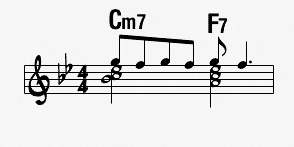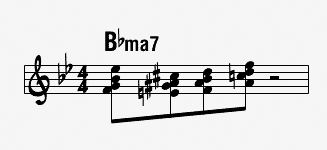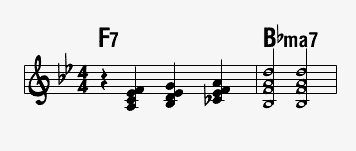What is Voicing?
Voicing means harmonising a melody (or lead) with one or more instruments or voices, either with a similar instrument from the same section or with a combination. Block voicing is where the inside or harmony parts always move in the same direction as the lead. This type of harmony works well for the typical jazz orchestra (four trumpets, five saxophones, four trombones and rhythm section) but can also be used in many styles of pop and rock, e.g. for horn sections or backing vocals. Voicing can be used either on the actual melody or for a chordal accompaniment (backing).
If you are wondering why the sub menu shows four-part first, the reason is that it is actually easier than three- or two-part, because with those decisions need to be made about chord notes to leave out, so I suggest you start off with four-part.
General Rules
- When writing for sections (eg all saxes or all trumpets) the melody part is usually the highest part but this is not always the case. When harmony parts are above the lead, care must be taken with the dynamics to allow the lead to be heard as a distinct melodic line.
- In mixed ensembles the lead line is not necessarily the top line but should be on the loudest instrument.
- A semitone interval between the melody and the second voice should be avoided
- A syncopated note anticipating a beat by an eighth note or less is usually harmonised with the chord of the beat following the anticipation.
- Do not combine an anticipation in one instrument or section with an on beat note in another section.
- In most cases the melody note should not be lower than middle C (C3) or harmonised parts will sound muddy.
- Usually a bass line is played in the rhythm section so only the melody (lead) and inside parts need to be written for a section. Any bass parts in the harmonisation must be consistent with the bass in the rhythm section.
- As the voices are moving in parallel motion, you can ignore strict voice-leading rules of classical harmony do not need to apply, though there are situations where attention to voice-leading is a good thing to have.
Apply these rules when learning the basics. Advanced arrangers may break them (at their own risk), but as always it’s important to learn the rules before you break them.
Part 1: Four Part Close Voicing
We start with Four part voicings as they are actually more straightforward than two- and three-part. This is because all four chord tones are used. With fewer than four voices we need to make decisions about which notes to omit so we look at those later in part 2.
This is actually quite easy, you take the melody line and add the three other notes of the chord beneath without omitting any:

As the melody of the Bb chord on beat one of bar 2 is the root, we use a Bb6 not a Bbmaj7 to avoid a semitone interval at the top of the chord, but semitone intervals are no problem in inside parts. Unless a 6th chord lasts for more than one beat it is unnecessary to include it as a chord symbol for the rhythm section. (An exception would be if a rhythm section instrument was voicing chords along with the horns instead of comping)
Extensions
These are either defined by the melody or added to inside parts for color. The rhythm section parts should include any extensions or alterations that last longer than one beat.
Extensions are usually treated as (unprepared) suspensions, 13th replaces 5th, 11th replaces 3rd, 9threplaces root.
Allowable extensions and altered extensions:
| Chord type: | Maj 7 | Maj 6 | Min 7 or min7b5 | Dominant 7 |
| 9 | 9 | 9 | 9, 11, 13 | |
| #11 | #11 | 11 | b9, b10 (#9) | |
| 13 (rare) | #11 (b5) | |||
| b13 (+5) |
Use with 4 part block voicing
| Extension | Omit | |
| 13 | 5 | Unusual in inside parts |
| b13 | 5 | Often treated as augmented 5th |
| 11 | 3 | Use sparingly in inside parts |
| #11 | 5 | Often treated as b5th |
| 13 or b13 with #11 | 5 and root | With only four parts the 9th would also be omitted as the 3rd and 7thare necessary |
| 9 or b9 | Root | Use freely in inside parts |
| b10 (#9) | Root | Often a suspensionof b9. Faster passages can omit 3rd instead of root for smoother voice leading, but does not sound as dissonant. |
9ths
9ths and altered 9ths are treated as suspensions of the root and always replace it, so the next chord note down is a 7th. In addition to 9ths in the lead, they can be freely used in inside parts for added interest. As with 6ths, unaltered 9ths do not need to be included in the rhythm section chord symbols unless they are used for the entire duration of a chord.

11ths
11ths on a dominant 7 usually omit the 3rd, so can be viewed as slash
chords, eg a C11 (Gm7/C) would be voiced as a Gm7. (You can ignore the C as it is covered by the bass). 11ths on a minor 7 do not need to omit the 3rd, but for close voicing it is best to treat them the same as above.
13ths
13ths can be treated as suspensions of the 5th so the next note down is the 3rd.

Sharp 11ths
Usually a #11th can be treated as a b5, so the next note down is the 3rd.

Non-Chord Notes
Passing notes
Passing notes are notes that occur in a step between two chord notes. In some cases they can be harmonised as if they are substituted for a note of the given chord (eg. a suspension or upper extension), or they can be harmonised with other passing notes to create a new passing chord (very often a passing diminished).

In ex 6A the Eb is harmonised as if it is an 11th or a suspended 4th. The F# is harmonised with a diminished chord. There is no movement between the first two notes of voices two, three and four. At slow tempos this is not a problem, but at medium and fast tempos there may be articulation problems, especially if the lead instrument is playing legato. The passing diminished chord in ex 6B is preferable as two of the three harmony voices are now moving. The harmonic impact of the passing chords become less important at faster tempos, but the need to minimise repeated notes in inside parts where the lead is moving becomes greater and it is usually possible to create movement in all voices, see ex 7:

- The first note is harmonised with a Bb6 instead of major 7 to allow voice three to move from G to A.
- The F# in the second chord has been changed to G to give a smoother melodic line.
- The fourth voice of the final chord has been changed to a 9th to allow movement A-Bb-C instead of the repeated A on the second and third chords. Harmonically this is not as good as the passing diminished but will allow for a smoother performance at fast tempos.
TIP: It is a good idea to harmonise the chord notes before harmonising the passing notes.
A passing diminished should not usually be used with a dominant chord. In many cases we just assume it is an extension:

In ex 8 the passing note at beat three is harmonised as a 9th, replacing the root of the previous beat resulting in static inside parts. If you want the extra movement you would get from a passing chord as opposed to just one passing nate that is thought of as an extansion (as above) then you can usually use the minor 7th chord whose root is a fifth higher, in this case a Cmin7:

Here the lower part is moving nicely (in sixths with the top part) but the second and third parts are still static. The Eb is necessary to the F7 chord, especially at slower tempos, so will need to stay but a Cm9 can be used to give more movement:

The Cm9 at beat 3 allows two of the three inside parts to move.
Chromatic Neighbour notes and auxiliaries
These can be harmonised with a chord of the same type moving in parallel or diminished chords:

Both of these harmonisations where chosen to allow movement in the inside parts.
Diatonic neighbour notes and auxiliaries
These are usually treated as suspensions or extensions. The following example shows how lower auxiliaries can be reharmonised on a IIm7-V7-I

The F in the Cm7 is harmonised with an F7, the G in the F7 is harmonised with a Cm7. In 12 (B) the Cm9 is used to give more movement to the third part.
A typical harmonisation of this passage could also have used sustained inside parts:

Changing tones (enclosure)

Ex 14The first note is harmonised as a suspension, the second note as a lower chromatic neighbour note with a chord of the same type moving in parallel.
Open Voicing
Open voicing can make a nice contrast to closed (block) voicing. The simplest method is to drop the second voice down an octave. Entire passages can be either open or close, or can use a combination.

Here the voicing is open on the Bb ma7 chord. This works well as the melody is moving by a larger interval and a b5 on the last beat of the V7 gives some strong voice leading at the cadence.
Five Part
- Same as for four-part close voicing but with melody doubled an octave lower.
- Same as for four-part open voicing but with the fifth part on roots
- Clusters: add the 6 and 9 to triads; add the 9 to 7 chords. Close or open. The lead can be doubled in octaves to create a sixth voice. Clusters work well where a more dissonant sound is required or to add some tension to more traditionally voiced chords.
Part 2
Two Part
The conventions of two-part writing specify:
- The interval between melody and harmony line is a third or a sixth.
- The note chosen for the harmony should be a chord note if the melody is a chord note.
- If the melody is a passing note the harmony part is often a passing note.
- All thirds or all sixths can sound bland.
- When choosing between third or sixth voice leading and good melodic movement in the harmony part should be taken into account.
In mainstream jazz arranging other intervals can be used occasionally either to create tension through dissonance or when a more melodic harmony line results:
| Interval between lead and harmony | |
| major 2nds and minor 7ths | Dissonant – should be used only when stylistically appropriate. Avoid if in doubt. |
| minor 2nds, major 7ths | Very dissonant – useful for special effects |
| flattened/augmented 5ths (#4ths) | Can be used where the given chord requires |
| perfect 5ths, 4ths | Sound weak when combined with 3rds and 6ths, but can be used where stylistically appropriate (eg modal jazz) |
Where the melody note is a chord tone, the harmony note should be a chord tone. Where the melody is a passing note or extension the harmony is often also a passing note or extension. The weaker intervals can be used on weak beats to avoid leaps in the lower part. Be careful of thinking of the 6th in a chord as a proper harmony note, its main function is to add thickness or coloration in four-part harmony and its use in two-part may imply a different chord. Long passages containing all 3rds or all 6ths should be avoided, but constant alternating between 3rds and 6ths should only be used when a better melodic harmony line results.
Three Part
Harmonise the melody in the same way as for four-part but only add two other chord notes from the lead downwards. One of the four chord notes will have to be omitted:
- In all chords there must be a 3rd and 7th (except when the root of a major 7 is in the lead, in which case the 3rd and 6th ).
- Perfect 5ths can be omitted from chords, and so can roots provided there is a bass instrument somewhere playing them. Where there is a choice of note use the one that gives the best melodic movement in the harmony parts.
- If the chord requires an altered 5th then that note should be used and the root should be omitted.
Full Ensemble (Tutti)
There are many methods of writing full ensemble for the jazz orchestra. Here are two very basic methods:
Combining sections.
Write close voicing for trumpets, close or open voicing for trombones immediately below them, add the saxes written with open voicing with the lead alto doubling the 2nd or 3rd trumpet.
Big Chords
Add chord tones downwards from the lead as with four-part. When writing big chords
spread across the entire ensemble use smaller intervals high up, larger intervals low down. Roots and 5ths can be doubled, take care doubling 3rds. Avoid upper extensions low down. (See Russo – Composing For The Jazz Orchestra)
Tips & Hints
- Transcription of existing arrangements is one of the best ways to learn, not just the rules but how different arrangers have created their individual styles, by bending or breaking the rules, or creating their own.
- Write legibly.
- Do not write transposed scores.
- However large the ensemble, unisons and octaves should not be ignored. They can be very powerful, or supply a contrast to thick harmony. When using backing figures or counterpoint it often works well to have the lead in harmony and the backing in unison, or vice versa. It can be very effective to use unison on an anacrusis (pickup) or faster melodic passages, followed by open or closed harmony on slower moving lines.